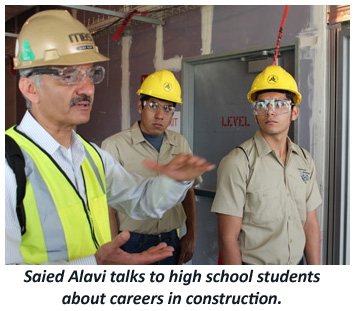 In my business today, as in the great building traditions of the past, skilled well-trained crafts people are our most important and valuable asset. From the hundreds who make up our field employees to the estimating and administrative teams who support them, from the youngest trainee and intern to the most senior supervisor – each one is critical to the delivery of our craft at Marek.
In my business today, as in the great building traditions of the past, skilled well-trained crafts people are our most important and valuable asset. From the hundreds who make up our field employees to the estimating and administrative teams who support them, from the youngest trainee and intern to the most senior supervisor – each one is critical to the delivery of our craft at Marek.
On any day, you can pick up the phone and order a hundred new screw guns or chop saws and receive delivery in a day or two. You can place an order for truckloads of gypsum board or metal studs and receive delivery in a few days. However, if you need ten experienced drywall or acoustical ceiling mechanics, there is no guarantee that you can find them in a week or even a month. And finding skilled workers is becoming more of a daily problem as the economy recovers and construction expands again.
In the mid-1980s, with the collapse of Houston and Texas construction businesses, many construction companies turned to cheap labor in order to be the low cost provider and to stay in business. Many of the skilled workers either found new industries or moved to other cities. Over the next decade, the skilled and trained workforce shrunk. Not only that, but also the shift of focus to science and technology in the schools drastically reduced the opportunity for young people graduating from our high schools to enter the construction industry. Pushing graduating high school students toward the four year college path even when a student did not show the desire to go to college exacerbated the problem. The vocational and technical programs that supplied workers in the past were slowly terminated in favor of those high tech programs that we were told the “new” business world needed.
Today, the average entry age of construction workers is 29, and the average age of the seasoned worker is 49 or 50.
After 25 years of using low-wage, and many times, illegal immigrant laborers to build our buildings, schools and health care facilities, we have reached a critical impasse. The designs of hospitals, research and industrial facilities and office buildings that have emerged during the last decade are more complex and complicated. The skills required to build these new sophisticated buildings are more complicated, and the number of skilled craftspeople available to build them has shrunk. The shrinking supply issue has awakened some construction company owners and executives to the realization that something has to change in order to attract skilled employees who can speak, read, write, and understand the math required to build the new buildings today.
After over 25 years of having only one track to pursue – college – many of our young people who did not go to college have had no choice but to go to “dead end” retail or fast food businesses. Our industry and educational leaders have now realized that construction and manufacturing are important and that we need other viable career options for students who are not on a college track. To meet the growing need for the number of skilled workers in the construction industry, many of our school districts and community colleges have started enhanced craft training programs. These programs are started as early as middle school so that students’ choices of possible futures include careers in construction.
We business owners and executives must realize and acknowledge that for our schools to be successful in training our future employees, they need partners. We can’t wait for the schools to train and prepare the work force that we need and expect them to just deliver them to us when we need them. We need to become partners with our schools and help them prepare the kind of employees that we need for the future. We can help teach and educate students about our craft trades and the opportunities in construction that are available to them. As partners with the schools, we can teach students the skills that they need to have when they show up at our doors looking for a job. This is a winning combination for the students, the schools, and for our industry.
At Marek, we have partnered with the Pasadena ISD to establish and support their craft training program. This program has produced hundreds of trained workers who are available to our industry, but it is only a start. The partnership with schools that offer craft training programs is a long-term plan that will change the construction industry.
We would encourage other construction and manufacturing companies to get involved and to help provide constructive careers for the students of tomorrow. We, at Marek, look forward to using this partnership model with other school districts.
What are you doing to help address this growing issue?

